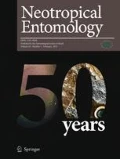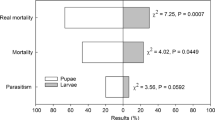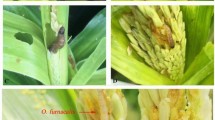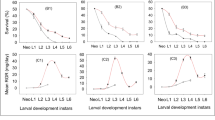Abstract
Sugarcane is one of the most economically important crops in Brazil. The damage caused by Diatraea saccharalis (F.) (Lepidoptera: Crambidae) results in high costs for its production. Cotesia flavipes Cameron (Hymenoptera: Braconidae) is the most efficient means of controlling this pest. The prohibition of burning and the preservation of soil cover through non-tillage practices increased many population densities of natural enemies of the sugarcane borer (SCB) in sugarcane fields. Euborellia annulipes (Lucas) (Dermaptera: Anisolabididae) is a predator found in sugarcane fields and is associated with predation of SCB. This study aimed to evaluate the influence of parasitism of D. saccharalis by C. flavipes on predation by E. annulipes adult females. For this purpose, fourth instar sugarcane borer larvae were exposed to parasitism over a 5-day period or were not parasitized. Subsequently, the prey was supplied to the predator in arenas under choice and no-choice conditions and under different densities to evaluate the feeding preference over a 12-h period and functional response of the predator over a 24-h period. E. annulipes killed 2–3 fourth instar larvae of the sugarcane borer over a 12-h period. SCB parasitism did not affect the feeding preference of the predator and did not alter the type II functional response. However, the handling time of the predator was lower (1.943 h) and there was a higher T/Th ratio on the non-parasitized larvae (12.352). Our findings indicate E. annulipes as a promising biological control agent of D. saccharalis, with a potential to assist in the sugarcane borer management approaches and could to reduce the costs of parasitoid release in the field.


Similar content being viewed by others
References
Abramson CI, Wanderley PA, Miná AJS, Wanderley MJA (2007) Capacity of earwig Marava arachidis (Yersin) to access fennel plants Foeniculum vulgare Mill in laboratory and field. Ciênc Rural 37:1524–1528
Attarzadeh M, Rajabpour A, Farkhari M, Rasekh A (2019) Interactions between Orius albidipennis and Aphidius colemani (Hymenoptera: Braconidae) for the control of Aphis gossypii on greenhouse cucumber. J Crop Prot 8:21–31
Beckage NE, Gelman DB (2004) Wasp parasitoid disruption of host development: implications for new biologically based strategies for insect control. Annu Rev Entomol 49:299–330
Bento CB, Filoso S, Pitombo LM, Cantarella H, Rossetto R, Martinelli LA, Carmo JB (2018) Impacts of sugarcane agriculture expansion over low-intensity cattle ranch pasture in Brazil on greenhouse gases. J Environ Manag 206:980–988
Beuzelin JM, Akbar W, Mészáros A, Reay-Jones FPF, Reagan TE (2010) Field assessment of novaluron for sugarcane borer, Diatraea saccharalis (F.) (Lepidoptera: Crambidae), management in Louisiana sugarcane. Crop Prot 29:1168–1176
Bilu E, Coll M (2009) Parasitized aphids are inferior prey for a coccinellid predator: implications for intraguild predation. Environ Entomol 38:153–158
Bordonal RO, Carvalho JLN, Lal R, Figueiredo EB, Oliveira BG, La Scala JN (2018) Sustainability of sugarcane production in Brazil. A review. Agron Sustain Dev 38:13. https://doi.org/10.1007/s13593-018-0490-x
Botelho PSM, Macedo N (2002) Cotesia flavipes para controle de Diatraea saccharalis. In: Parra JRP, Botelho PSM, Corrêa-Ferreira BS, Bento JMS (eds) Controle biológico no Brasil: parasitoides e predadores. Manole, São Paulo, pp 409–425
Bukovinszky T, van Veen FF, Jongema Y, Dicke M (2008) Direct and indirect effects of resource quality on food web structure. Science 319:804–807
Butler SJ, Vickery JA, Norris K (2007) Farmland biodiversity and the footprint of agriculture. Science 315:381–384
Chailleux A, Bearez P, Pizzol J, Amiens-Desneux E, Ramirez-Romero R, Desneux N (2013) Potential for combined use of parasitoids and generalist predators for biological control of the key invasive tomato pest Tuta absoluta. J Pest Sci 86:533–541
Chailleux A, Wajnberg E, Zhou Y, Amiens-Desneux E, Desneux N (2014) New parasitoid-predator associations: female parasitoids do not avoid competition with generalist predators when sharing invasive prey. Naturwissenschaften 101:1075–1083
Cherubin MR, Franco AL, Guimarães RM, Tormena CA, Cerri CE, Karlen DL, Cerri CC (2017) Assessing soil structural quality under Brazilian sugarcane expansion areas using Visual Evaluation of Soil Structure (VESS). Soil Tillage Res 173:64–74
Colfer RJ, Rosenheim JA (2001) Predation on immature parasitoids and its impact on aphid suppression. Oecologia 126:292–304
Coll M, Wajnberg E (2017) Environmental pest management: challenges for agronomists, economists, and policymakers. John Wiley and Sons 448 pp
Di Stefano J (2005) Effect size estimates and confidence intervals: an alternative focus for the presentation and interpretation of ecological data. In: Burk AR (ed) New trends in ecology research. New York, Nova Science, pp 71–102
Dias-Pini NDS, Broglio SMF, Costa SDS, Santos JMD, Guzzo EC (2012) Biological characteristics of Telenomus alecto and Trichogramma galloi reared on eggs of the sugarcane borer Diatraea flavipennella. Rev Bras Entomol 56:515–518
Dinardo-Miranda LL (2008) Pragas. In: Dinardo-Miranda LL, Vasconcelos ACM, Landell MGA (eds) . Cana-de-açúcar. Campinas, Instituto Agronômico, pp 349–404
Dinardo-Miranda LL, Anjos IAD, Costa VPD, Fracasso JV (2012) Resistance of sugarcane cultivars to Diatraea saccharalis. Pesq Agropec Bras 47:1–7
Dinardo-Miranda LL, Fracasso JV, Costa VP, Lopes OT (2014) Dispersal of Cotesia flavipes in sugarcane field and implications for parasitoid releases. Bragantia 73:163–170
Frago E (2016) Interactions between parasitoids and higher order natural enemies: Intraguild predation and hyperparasitoids. Curr Opin Insect Sci 14:81–86
Franco AL, Bartz ML, Cherubin MR, Baretta D, Cerri CE, Feigl BJ, Wall DH, Davies CA, Cerri CC (2016) Loss of soil (macro) fauna due to the expansion of Brazilian sugarcane acreage. Sci Total Environ 563:160–168. https://doi.org/10.1016/j.scitotenv.2016.04.116
Freitas FC, Castro AMC, Barbosa NCCP, Fernandes OA (2018) Characterization and comparison of genetic variation in Cotesia flavipes (Hymenoptera: Braconidae) mass reared for biological pest control using microsatellite markers. Neotrop Entomol 47:433–439
Gontijo LM, Beers EH, Snyder WE (2015) Complementary suppression of aphids by predators and parasitoids. Biol Control 90:83–91
Hassell MP, Lawton JH, Beddington JR (1977) Sigmoid functional responses by invertebrate predators and parasitoids. J Anim Ecol 46:249–262
Herrick NJ, Reitz SR, Carpenter JE, O’Brien CW (2008) Predation by Podisus maculiventris (Hemiptera: Pentatomidae) on Plutella xylostella (Lepidoptera: Plutellidae) larvae parasitized by Cotesia plutellae (Hymenoptera: Braconidae) and its impact on cabbage. Biol Control 45:386–395
Holling CS (1959) Some characteristics of simple types of predation and parasitism. Can Entomol 91:384–398
Holling CS (1966) The functional response of invertebrate predators to prey density. Mem Entomol Soc Can 98:5–86
Huang F, Leonard BR, Andow DA (2007) Sugarcane borer (Lepidoptera: Crambidae) resistance to transgenic Bacillus thuringiensis maize. J Econ Ecol 100:164–171
Juliano SA (2001) Nonlinear curve fitting: predation and functional response curves. In: Scheiner SM, Gurevitch J (eds) Design and analysis of ecological experiments. Oxford University Press, New York, pp 178–196
Kaçar G, Wang XG, Biondi A, Daane KM (2017) Linear functional response by two pupal Drosophila parasitoids foraging within single or multiple patch environments. PLoS ONE 12:e0183525
Kharboutli MS, Mack TP (1993) Effect of temperature, humidity, and prey density on feeding rate of the striped earwig (Dermaptera: Labiduridae). Environ Entomol 22:1134–1139
Klostermeyer EC (1942) The life history and habits of the ringlegged earwig, Euborellia annulipes (Lucus) (Order Dermaptera). J Kansas Entomol Soc 15:13–18
Kocarek P, Dvorak L, Kirstova M (2015) Euborellia annulipes (Dermaptera: Anisolabididae), a new alien earwig in Central European greenhouses: potential pest or beneficial inhabitant? Appl Entomol Zool 50:201–206
Lemos WP, Ramalho FDS, Zanuncio JC (2003) Age-dependent fecundity and life-fertility tables for Euborellia annulipes (Lucas) (Dermaptera: Anisolabididae) a cotton boll weevil predator in laboratory studies with an artificial diet. Environ Entomol 32:592–601
Manly BJF (1974) A model for certain types of selection experiments. Biometrics 30:281–294
Michaud JP (2018) Problems inherent to augmentation of natural enemies in open agriculture. Neotrop Entomol 47:161–170
Moral RA, Demétrio CGB, Hinde J, Godoy WAC, Fernandes FS (2017) Parasitism-mediated prey selectivity in laboratory conditions and implications for biological control. Basic Appl Ecol 19:67–75
Muştu M, Kilinçer N, Ülgentürk S, Kaydan MB (2008) Feeding behavior of Cryptolaemus montrouzieri on mealybugs parasitized by Anagyrus pseudococci. Phytoparasitica 36:360–367
Naranjo-Guevara N, Peñaflor MFG, Cabezas-Guerrero MF, Bento JMS (2017) Nocturnal herbivore-induced plant volatiles attract the generalist predatory earwig Doru luteipes Scudder. Sci Nat 104:77
Negm AA, Hensley SD (1969) Evaluation of certain biological control agents of the sugarcane borer in Louisiana. J Econ Entomol 62:1008–1013
Nunes GS, Dantas TAV, Figueiredo WRS, Souza MDS, Nascimento IN, Batista JL (2018) Predation of diamondback moth larvae and pupae by Euborellia annulipes. Rev Bras Cienc Agr 13:5557
Nunes GS, Dantas TAV, Souza MS, Nascimento IN, Batista JL, Malaquias JB (2019) Life stage and population density of Plutella xylostella affect the predation behavior of Euborellia annulipes. Entomol Exp Appl 167:544–552
Parra JRP, Coelho A (2019) Applied biological bontrol in Brazil: from laboratory assays to field application. J Insect Sci 19:5
Pennacchio F, Strand MR (2006) Evolution of developmental strategies in parasitic Hymenoptera. Annu Rev Entomol 51:233–258
Pineda S, Cruz G, Valle J, De La Rosa JF, Chavarrieta JM, Ordoñez-Reséndiz M, Martínez AM (2012) Arthropod abundance in two maize fields in western central Mexico. J Kansas Entomol Soc 85:340–352
Poelman EH, Harvey JA, Loon JJ, Vet LE, Dicke M (2013) Variation in herbivore-induced plant volatiles corresponds with spatial heterogeneity in the level of parasitoid competition and parasitoid exposure to hyperparasitism. Funct Ecol 27:1107–1116
Polis GA, Myers CA, Holt RD (1989) The ecology and evolution of intraguild predation: potential competitors that eat each other. Annu Rev Ecol Syst 20:297–330
Pratissoli D, Grecco ED, Nihei SS, Polanczyk RA, Celestino FN, Carvalho JD, Barbosa WF (2010) Ocorrência de Lixophaga sp. (Diptera: Tachinidae) parasitando lagartas de Diaphania nitidalis (L.) (Lepidoptera: Crambidae) em Cucurbita moschata no Brasil. Arq Ins Biol 77:719–721
Ramamurthi BN, Solayappan AR (1980) Dermapteran predators in the biological regulation of sugarcane borers in India. Curr Sci 49:72–73
Rankin SM, Palmer JO (2009) Dermaptera: (Earwigs). In: Resh VH, Cardé RT (eds) Encyclopedia of insects. Academic Press, New York, pp 259–261
Rogers D (1972) Random search and insect population models. J Anim Ecol 41:369–383
Rossoni C, Loureiro EDS, Pereira FF, Kassab SO, Costa DP, Barbosa RH (2014) Selectivity of Metarhizium anisopliae and Beauveria bassiana (Hypocreales: Clavicipitaceae) on adults of Cotesia flavipes (Hymenoptera: Braconidae). Folia Biol 62:269–275
Roy S, Roy MM, Jaiswal AK, Baitha A (2018) Soil arthropods in maintaining soil health: thrust areas for sugarcane production systems. Sugar Tech 20:1–16
Sabelis MW (1992) Predatory arthropods. In: Crawley MJ (ed) Natural enemies, the population biology of predators, parasites and diseases. Blackwell Scientific, Oxford, pp 225–264
Sandhu HS, Cherry RH (2014) Effects of tillage practices on arthropod ground predators in florida sugarcane. J Entomol Sci 49:415–419
Santos LAO, Naranjo-Guevara N, Fernandes OA (2017) Diversity and abundance of edaphic arthropods associated with conventional and organic sugarcane crops in Brazil. Fla Entomol 100(1):134–144
SAS Institute (2015) SAS/IML® User’sGuide. SAS Institute, Cary
Shah MA, Khan AA (2013) Functional response- a function of predator and prey species. Bioscan 8:751–758
Sherratt T, Harvey IF (1993) Frequency-dependent food selection by arthropods: a review. Biol J Linn Soc 48:167–186
Showler AT, Reagan TE (1991) Effects of sugarcane borer, weed, and nematode control strategies in Louisiana sugarcane. Environ Entomol 20:358–370
Sidhu JK, Stout MJ, Blouin DC, Datnoff LE (2013) Effect of silicon soil amendment on performance of sugarcane borer, Diatraea saccharalis (Lepidoptera: Crambidae) on rice. Bull Entomol Res 103:656–664
Silva AB, Batista JL, Brito CH (2009) Capacidade predatória de Euborellia annulipes (Lucas, 1847) sobre Spodoptera frugiperda (Smith, 1797). Acta Sci Agron 31:7–11
Silva ITFA, Oliveira R, Oliveira LVQ, Nascimento Júnior JL, Batista JL (2018) Biological development of Euborellia annulipes reared with artificial diets and Ephestia kuehniella eggs. Pesq Agrop Trop 48:295–298
Silva-Brandão KL, Santos TV, Cônsoli FL, Omoto C (2015) Genetic diversity and structure of Brazilian populations of Diatraea saccharalis (Lepidoptera: Crambidae): Implications for pest management. J Econ Entomol 108:307–316
Simões RA, Reis LG, Bento JM, Solter LF, Delalibera I Jr (2012) Biological and behavioral parameters of the parasitoid Cotesia flavipes (Hymenoptera: Braconidae) are altered by the pathogen Nosema sp. (Microsporidia: Nosematidae). Biol Control 63:164–171
Snyder WE, Ives AR (2003) Interactions between specialist and generalist natural enemies: parasitoids, predators, and pea aphid biocontrol. Ecology 84:91–107
Solomon ME (1949) The natural control of animal populations. J Anim Ecol 18:1–35
Sueldo MR, Bruzzone OA, Virla EG (2010) Characterization of the earwig, Doru lineare, as a predator of larvae of the fall armyworm, Spodoptera frugiperda: a functional response study. J Insect Sci 10:38
Tomaz AC, Coutinho AE, Soares BO, Peternelli LA, Pereira EJG, Barbosa MHP (2017) Assessing resistance of sugarcane varieties to sugarcane borer Diatraea saccharalis Fab. (Lepidoptera: Crambidae). Bull Entomol Res 108:547–555
Tonnang HE, Nedorezov LV, Owino JO, Ochanda H, Löhr B (2009) Evaluation of discrete host–parasitoid models for diamondback moth and Diadegma semiclausum field time population density series. Ecol Model 220:1735–1744
Vacari AM, De Bortoli SA, Borba DF, Martins MI (2012) Quality of Cotesia flavipes (Hymenoptera: Braconidae) reared at different host densities and the estimated cost of its commercial production. Biol Control 63:102–106
van Veen FJF, Müller CB, Pell JK, Godfray HCJ (2008) Food web structure of three guilds of natural enemies: predators, parasitoids and pathogens of aphids. J Anim Ecol 77:191–200
Venzon M, Pallini A, Janssen A (2001) Interactions mediated by predators in arthropod food webs. Neotrop Entomol 30:1–9
Wiedenmann RN, Smith JW Jr, Darnell PO (1992) Laboratory rearing and biology of the parasite Cotesia flavipes (Hymenoptera: Braconidae) using Diatraea saccharalis (Lepidoptera: Pyralidae) as a host. Environ Entomol 21:1160–1167
Xue Y, Bahlai CA, Frewin A, McCreary CM, Des Marteaux LE, Schaafsma AW, Hallett RH (2012) Intraguild predation of the aphid parasitoid Aphelinus certus by Coccinella septempunctata and Harmonia axyridis. BioControl 57:627–634
Acknowledgements
The authors thank Usina São Martinho for helping with the material for the research
Funding
This study was financially supported by the Coordination for the Improvement of Higher Education Personnel – Brazil (CAPES – Finance Code 001) and the São Paulo State Foundation for Research Aid (FAPESP – Processo 18/00045-8).
Author information
Authors and Affiliations
Contributions
GSN planed and designed the work, conducted data analyses and wrote the manuscript; GSN, DGR, NAS, CCT, CPC and NFV executed experimental work; and SAB revised the manuscript.
Corresponding author
Additional information
Edited by Angelo Pallini – UFV
Publisher’s Note
Springer Nature remains neutral with regard to jurisdictional claims in published maps and institutional affiliations.
Rights and permissions
About this article
Cite this article
Nunes, G.S., Ramalho, D.G., dos Santos, N.A. et al. Parasitism-Mediated Interactions Between the Ring-Legged Earwig and Sugarcane Borer Larvae. Neotrop Entomol 48, 919–926 (2019). https://doi.org/10.1007/s13744-019-00731-3
Received:
Accepted:
Published:
Issue Date:
DOI: https://doi.org/10.1007/s13744-019-00731-3




